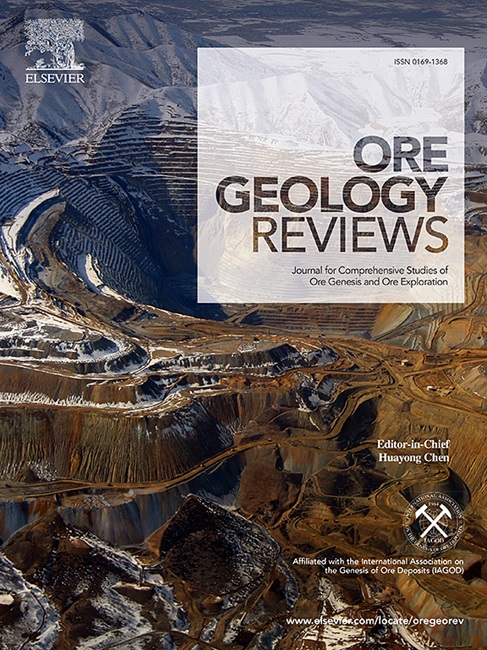新疆乌拉根铅锌矿床古地磁测年及地质意义
IF 3.2
2区 地球科学
Q1 GEOLOGY
引用次数: 0
摘要
乌拉根铅锌矿位于中国新疆塔里木盆地西北缘,处于中生代以来无数次构造运动形成的地质环境中。这一复杂的历史使得乌拉根铅锌矿床的沉积环境更加复杂,引发了围绕其成矿机制和年龄的争论。因此,对岩石磁学和古磁学的深入研究已势在必行。这项研究从23个不同的地点收集了400多个样品进行磁分析。岩石磁性实验表明,磁铁矿和赤铁矿是磁化的主要载体。古地磁分析采用热退磁和交变退磁技术,成功分离出稳定特征剩磁(CHRM),得到位于北纬81.7°和东经131.0°的古磁极,dp = 4.6, dm = 5.9。矿化事件的年龄为47.5±3.5 Ma。基于这些新数据,我们认为Uragen铅锌矿床可能是在印度板块与欧亚板块碰撞后形成的,引发了塔里木盆地内部的造山运动。喀什凹陷流体的活化和运移,加上下白垩统克孜勒苏群成矿流体与原岩之间的热化学或水化学相互作用,最终导致成矿作用的沉积,形成了已观察到的矿床。本文章由计算机程序翻译,如有差异,请以英文原文为准。

Paleomagnetic dating and geological significance of the Uragen Zn–Pb deposit, Xinjiang, NW China
The Uragen Zn–Pb deposit, situated in the northwestern margin of Xinjiang’s Tarim Basin, China, resides within a geological setting shaped by a myriad tectonic movements since the Mesozoic era. This complex history has complicated the depositional environment of the Uragen Zn–Pb deposit, fueling ongoing debate surrounding its mineralization mechanisms and age. Consequently, an in–depth investigation into rock magnetism and paleomagnetism has become imperative. This study collected over four hundred samples from 23 distinct sites for magnetic analysis. Rock magnetism experiments identified magnetite and hematite as the primary carriers of magnetization. Paleomagnetic analysis, employing thermal and alternating demagnetization techniques, successfully isolated stable characteristic remanent magnetism (CHRM), yielding paleopoles situated at 81.7°N latitude and 131.0°E longitude, with dp = 4.6 and dm = 5.9. The age of the mineralizing event was determined to be 47.5 ± 3.5 Ma. Based on these new data, we suggest that the Uragen Zn–Pb deposit may have formed in response to the collision between the Indian and Eurasian plates, triggering an orogeny within the Tarim Basin. Subsequent activation and migration of fluids in the Kashi Sag, coupled with thermal or hydro–chemical interactions between ore–forming fluids in the Lower Cretaceous Kezilesu Group and protoliths, culminated in the deposition of mineralization, giving rise to the observed ore deposit.
求助全文
通过发布文献求助,成功后即可免费获取论文全文。
去求助
来源期刊

Ore Geology Reviews
地学-地质学
CiteScore
6.50
自引率
27.30%
发文量
546
审稿时长
22.9 weeks
期刊介绍:
Ore Geology Reviews aims to familiarize all earth scientists with recent advances in a number of interconnected disciplines related to the study of, and search for, ore deposits. The reviews range from brief to longer contributions, but the journal preferentially publishes manuscripts that fill the niche between the commonly shorter journal articles and the comprehensive book coverages, and thus has a special appeal to many authors and readers.
 求助内容:
求助内容: 应助结果提醒方式:
应助结果提醒方式:


